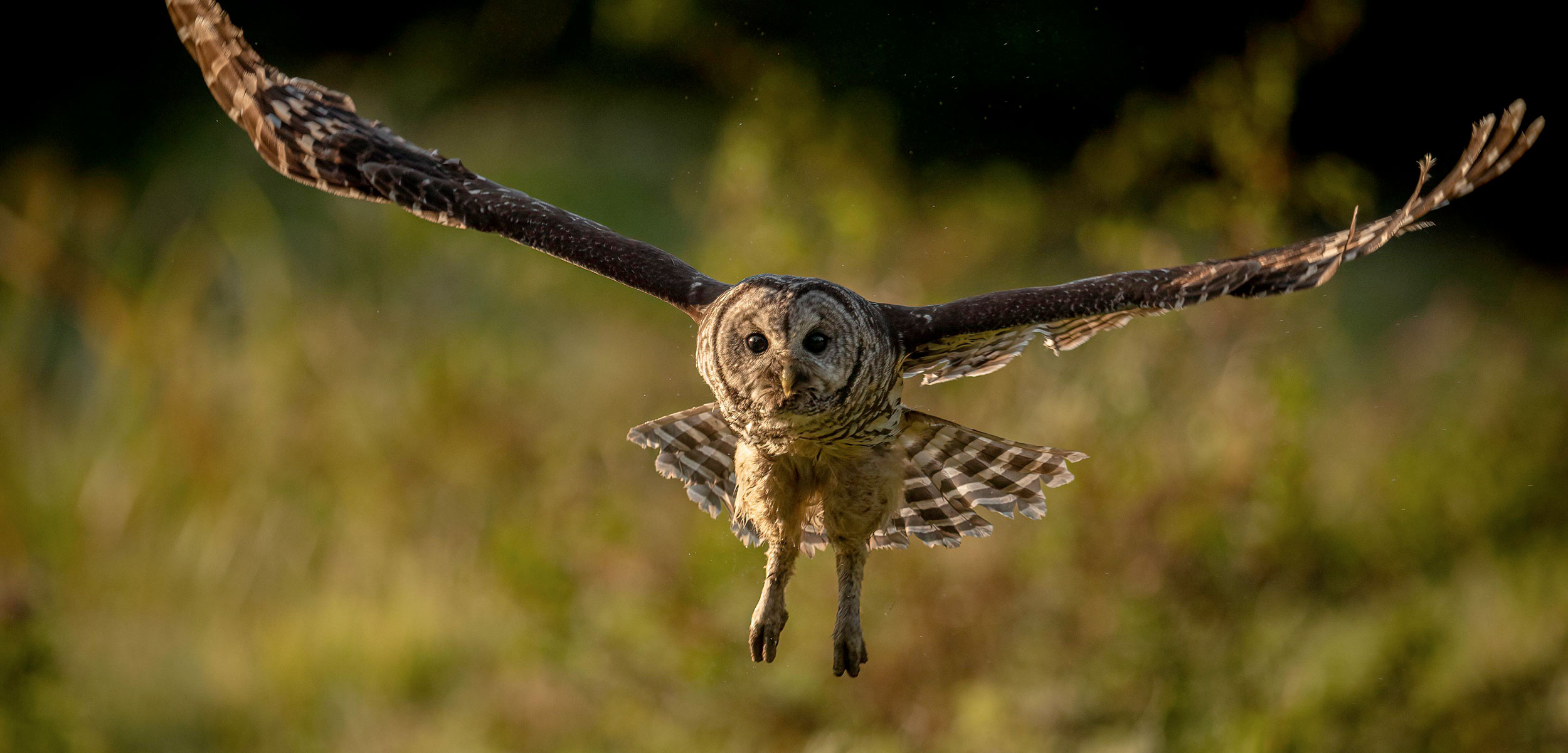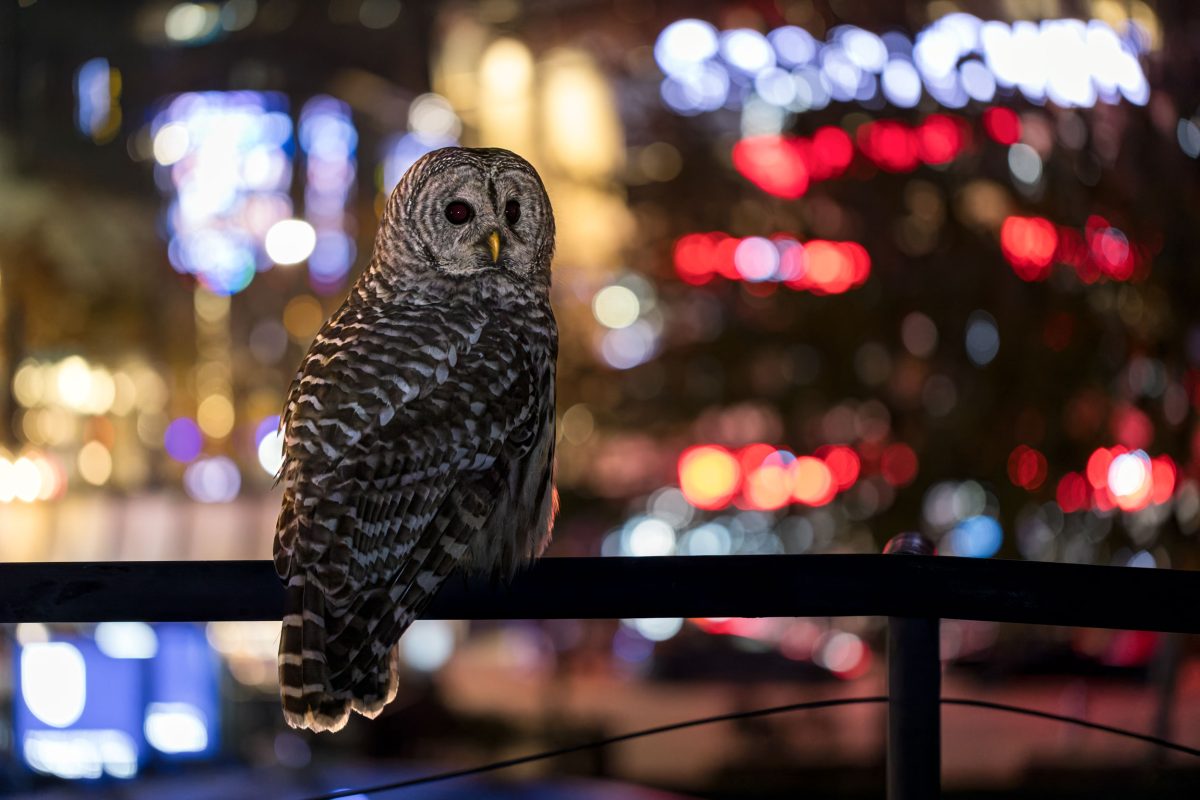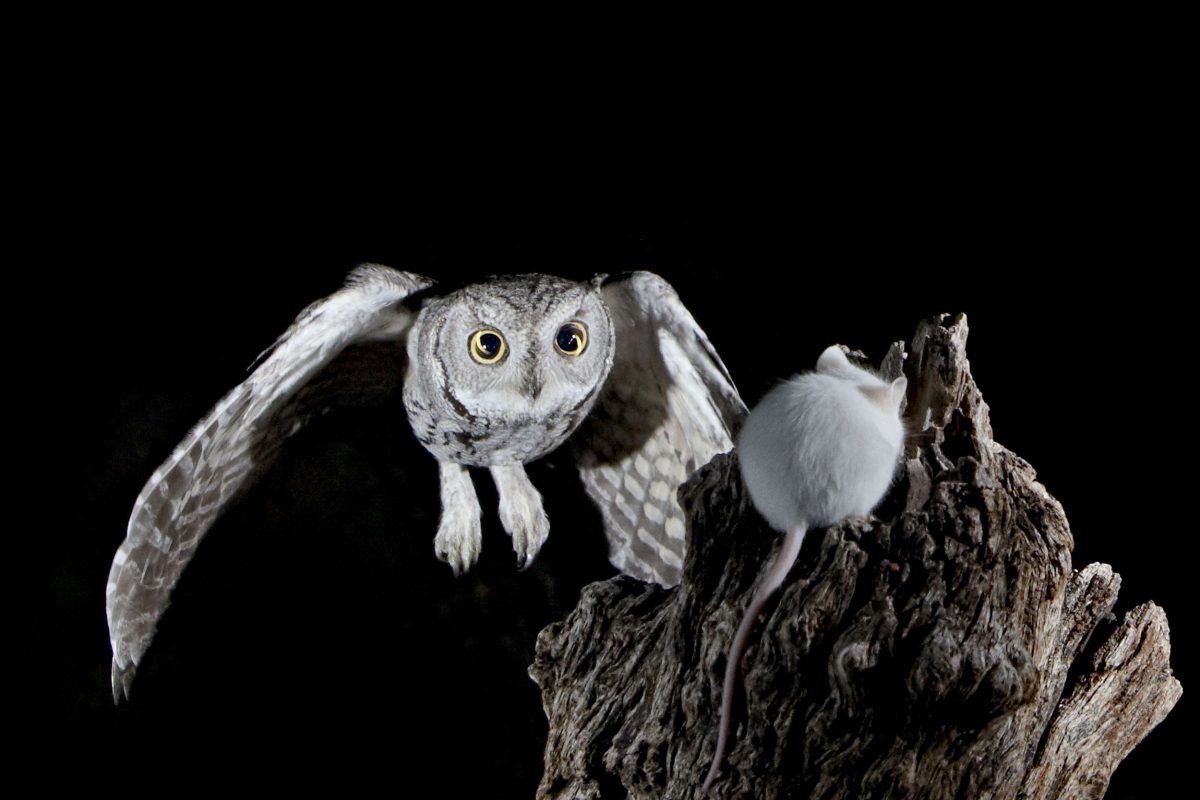The Owls Who Came From Away
Over the past 80 years, one of the most resilient and hearty owls has practically engulfed a continent. Not everyone is pleased.
Article body copy
At Home with Owls
They seize suburbs. They seize cities. They seize habitat a continent away. They arrive uninvited. They stay indefinitely. They are indomitable.
Who? Barred owls. Strix varia.
They have taken a fancy to the Pacific Northwest. From an Airbnb next to the I-5 highway plowing through Seattle, Washington, my friend sends me photos of a barred owl perched in a spruce tree outside the kitchen window. In a newspaper, I read about a barred owl in Vancouver, British Columbia, startling people at a bus stop as it swooped past with talons full of pigeon. And in my hometown of Victoria, British Columbia, I watch a squirrel race up and down a chestnut tree, chirping menacingly in a bid to browbeat a barred owl from the neighborhood. Wherever you go, there they are.
Over the past century or so, barred owls have swooped across North America from east to west, inspiring wonder, admiration, and fear about the future of other owls, often all at once. Their story is complicated, as are the labels people attach to them. Are they native or not? And what can their presence in the Pacific Northwest reveal about what it means to belong to a place at this particular moment in history?
Their Origins
Owls are old. Their fossil record is one of the oldest among birds alive today, and the oldest known owl fossil is from Colorado, dating to over 60 million years ago. Exactly when barred owls split from this ancestral bird of prey isn’t clear, but researchers have found barred owl fossils in Pleistocene deposits in Florida and Ontario, and in a Tennessee cave dating to 11,000 years ago. In 1905, Lenape poet Richard Calmit Adams, a member of the Delaware Tribe, published a traditional story called The Hunter and the Owl. In the story, the owl’s hooting laugh promises a successful hunt, and in turn, the hunter must share his bounty—specifically, a deer’s fat and heart, hung in a tree for the owl to consume. When the hunter fails to uphold his end of the bargain, the owl curses him. Considering the habitat and the owl’s laughlike hoot—whah-whah-whah-to-hooo—there’s good reason to conclude it was a barred owl teaching the hunter to keep his promises. Wise old owl.
Their Travels West
Barred owls live across the North American continent, but didn’t always. They arrived on the West Coast from the east via one of two routes. Or maybe both. The simplest story is that the owls crossed the Great Plains of the United States, flapping from one patch of trees to the next as arboreal stands emerged from grasslands once routinely shorn by bison and kept clear through fires lit by Indigenous peoples. As colonizers altered prairie ecosystems, the barred owl deduced a lucky break.
Or maybe Jim Duncan, an owl researcher in Manitoba, has it right. Based on research sussing out barred owl habitat in that province, Duncan thinks the owls found purchase in the boreal forest, an unbroken sheet of green stretching across the north, from Newfoundland to British Columbia, the Yukon, and Alaska. On its southeastern border, this boreal forest butted up against the historical woodland habitat of barred owls. Manitoba’s boreal forest, then, could have been a natural portal that allowed the raptors from the east to nest and head west.
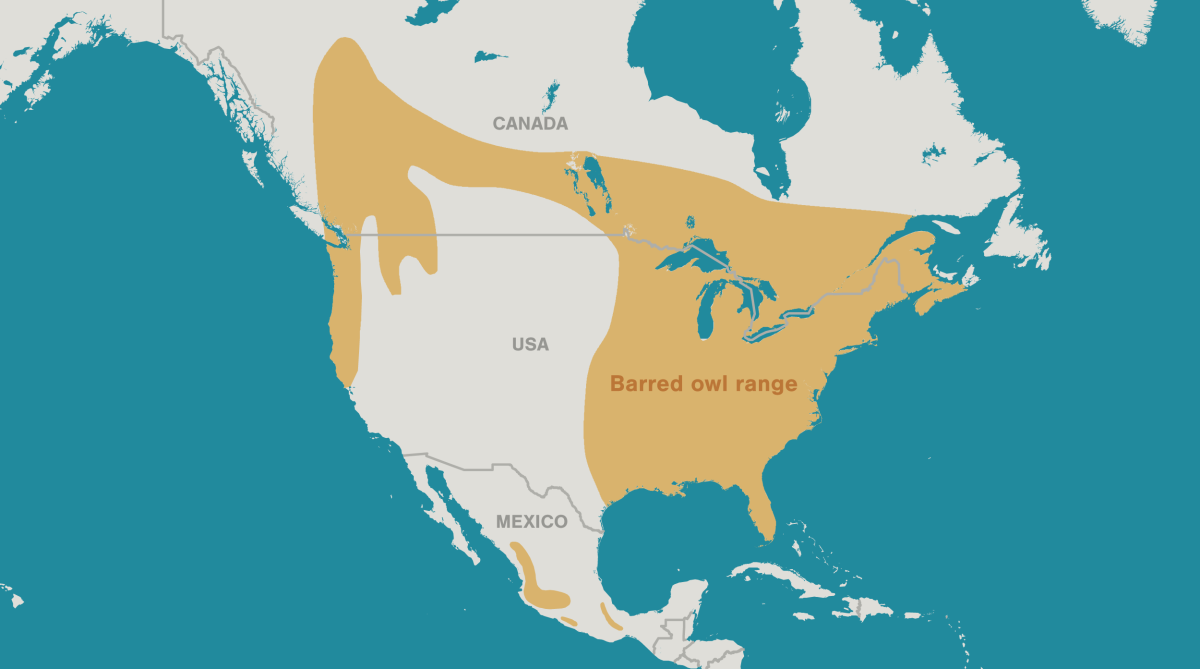
Barred owls are native to the eastern part of North America but the highly adaptive birds found pathways to the west. Map data from ArcGIS, with range data from IUCN
What They Look Like and How They Hear
A barred owl is a big bird, the height of an average bamboo backscratcher, about 50 centimeters tall. Their feathers form a shaggy cape streaked with bars the colors of coffee and cream. Their ruffled necks bring to mind Elizabethan royalty, or maybe paper coffee filters. Their wingspan is double their height. They weigh about the same as a liter or two of water. Females are bigger than males.
Their eyes are brown. Their heads are round, without ear tufts. Their ear openings are particularly large for an owl but, like other owls, their cochlea—a hollow tube that in many species transmits sounds to the brain—is three or four times as long as that of other birds, bestowing them with superb hearing. They have asymmetrical ears that give them an almost supernatural ability to locate sound through triangulation. And unlike us, they are impervious to age-related hearing loss: the hair cells that register sound in their cochlea regenerate throughout their relatively long lives, close to 20 years for wild barred owls.
What They Say
Most owls hoot. They hoot when about to mate, they hoot to claim territory, they hoot to warn others of predators. They hoot to say hi to each other. Owls are not songbirds, but ornithologists categorize the barred owl’s most familiar hoot as a song: who cooks for you, who cooks for you aaaallll? Which sounds more like ok-ok-ok-ok-ok-ok-ok-buhooooh. The French Canadian nickname for the owl is le chat-huant du nord, the howling cat of the north.
A mating pair performs a duet—what Edward Forbush, appointed Massachusetts state ornithologist in 1908, called “the most weird and uncouth sounds imaginable … [some] resembling maniacal laughter and others like mere chuckles.” Perhaps a demonstration of devotion is best expressed in barmy language incomprehensible to any but the devotees.
Easy to recognize, the call of the barred owl sounds like who cooks for you, who cooks for you aaaallll? A shorter version—whah-whah-whah-to-hooo—is a territorial, courtship, and hello call. Video by The Nature Conservancy in New Jersey
Where They Nest
A barred owl couple prefers a big tree and nearby water to successfully reproduce, and the Pacific Northwest offers plenty of both. Even its cities and suburbs often feature mature trees and an expansive canopy, habitat that resembles the bird’s original digs in the east. “It’s a good comparison, especially with the moisture,” says Marion Clément, who studied the owls as a graduate student at Clemson University in South Carolina. Both the university and its eponymous town are barred owl strongholds.
Urban trees in wet areas grow jumbo pretty quickly. Even larger cities offer lofty, foresty habitat. High humidity boosts slower-growing trees like oaks and blasts faster-growing trees like pines, maples, and cottonwoods beyond rooftops. Big trees have big cavities that barred owl couples need to fit their big bodies and big families of two to three offspring. In their historical forest habitat, the presence of plenty of barred owls conveys a message: welcome to a healthy, diverse ecosystem.
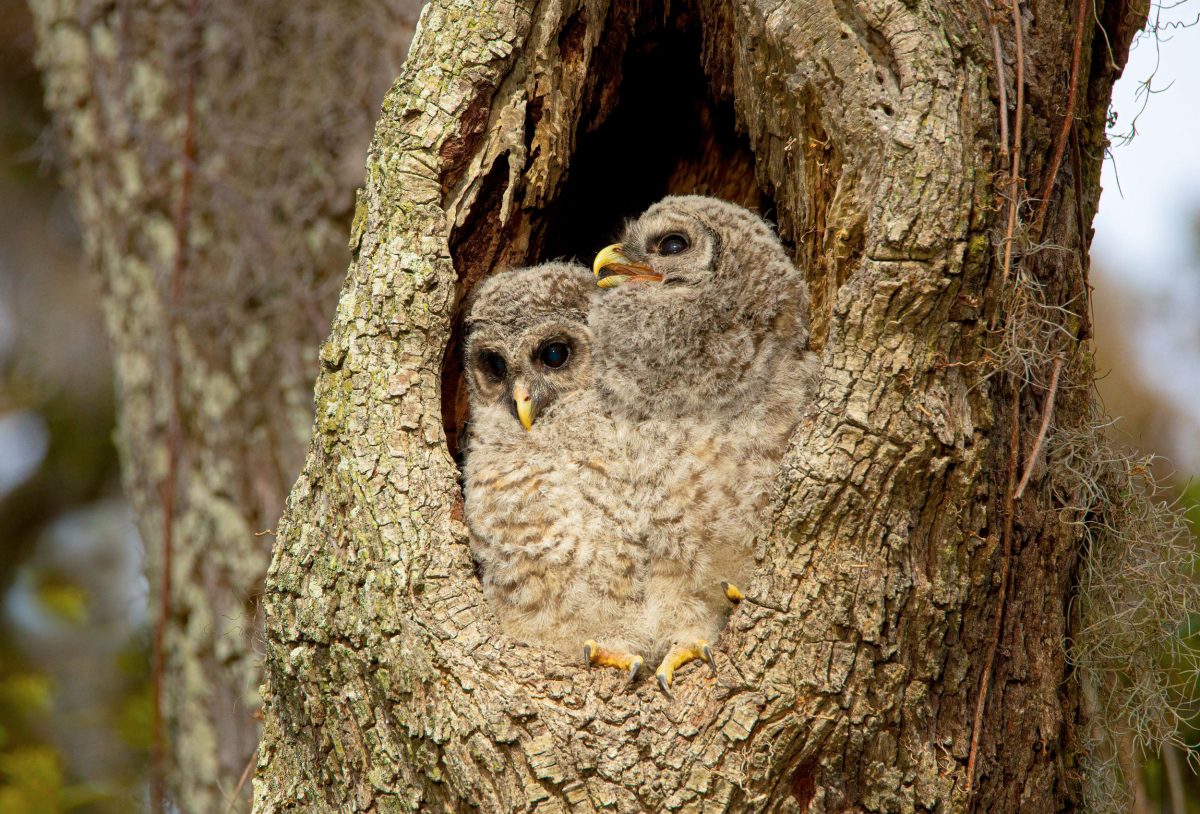
Barred owls need large trees with large cavities for their big bodies and big families. Photo by Danita Delimont/Alamy Stock Photo
Healthy, diverse forests in the east also typically have open areas, carved into the canopy by wind or ice storms or through natural stand development over time. Barred owls thrive in such patchiness; they sweep soundlessly through the open spaces to hunt for prey. Before colonists thoroughly logged the Pacific Northwest, barred owls might have struggled to survive in its comparatively dense old-growth forests. But just as settlers altered the Great Plains in a way that may have provided a conduit west, so too did industrial logging of the Pacific Northwest’s old-growth forests help the region feel more like home for barred owls.
And so the barred owl did what any species would do when limits on its establishment and growth are gone. As Charles Darwin observed in 1859, “Lighten any check, mitigate the destruction ever so slightly, and the number of species will almost instantaneously increase to any amount.” Many species go forth and proliferate when opportunity arises; the barred owl is no exception.
What They Eat
Squirrels, snakes, cicadas. Beetles, bluebirds, bunnies. Mice, millipedes, moles. Catholic in their tastes, barred owls prey on most anything their talons can grab. In biology-speak, they are generalists, and generalists in general thrive in city and suburban habitats, where they can choose from a jumble of dishes, all appealing. Rats are aplenty. Backyard ponds have koi. Hedges house songbirds. In winter, deciduous trees offer no protection, so songbirds gather in evergreen hedgerows, an assemblage not lost on barred owls. They hop on a hedge and stamp with their talons to flush the birds, “and then they just pluck them out of the air like popcorn,” Clément says. This is atypical barred owl behavior in a forest. But then, these are city birds.

Generalists, barred owls eat a wide variety of animals, including mice. Photo by Vlad Ghiea/Alamy Stock Photo
Place Determines Proclivities
Raptor researcher Rob Bierregaard studied barred owls in Charlotte, North Carolina, for 10 years, where he found 300 breeding pairs living within 16 kilometers of downtown. Once, Bierregaard was observing one of his favorite owls, whom he named Rosa, courting a much younger male. Bierregaard summoned the male with a whistle and a dead mouse, expecting him to offer the corpse to Rosa; instead the male grabbed the proffered prey and flew up to a tree branch near Rosa—but kept the lunch for himself. A game of chase ensued until Mr. Rosa learned the rules of courtship.
City owls, it seems, differ from country owls in several ways. While searching nests—wearing a lacrosse helmet for protection—Bierregaard found that for barred owls living in rural or wooded areas, variety was the rule, with birds making up only 15 percent of their menu. Charlotte owls? Over 50 percent of meals were birds. That surprised him: Wouldn’t suburban owls have more rodents at their disposal? Or, perhaps the open spaces of cities make it easier to snatch birds. Just about any bird smaller than themselves seems to pique the culinary curiosity of barred owls, other owls included.
Each habitat—city or country—offers its own carte du jour. In forested areas, barred owls add beetles to the mix, especially post-fledgling. In Saskatchewan, barred owls have been known to eat a heck of a lot of frogs. In the greater Vancouver area, barred owls mostly feast on young rats, field voles, and deer mice, in contrast to their city brethren in Charlotte.
Familiarity Leads to Fondness
Barred owls first materialized in British Columbia in 1943. They arrived on Vancouver Island by November 26, 1969. They settled in western Oregon by 1974, in Northern California by 1981, and in Seattle’s Discovery Park by 1982. So far, no one has recorded them in San Francisco or Southern California.
Everywhere they turn up, barred owls garner admirers. In Marion Clément’s study area a few years ago, a couple nested in a towering oak tree at a busy intersection. When the fluffy gray fledglings fledged, they landed on a sidewalk next to the road; concerned residents called Clément for advice on keeping the owlets from playing in traffic. “The mother [owl] had already punched one or two people in the head who had been walking their dogs or babies in strollers,” she says. Following Clément’s instructions, five locals carrying umbrellas to protect themselves from the panicked parents’ divebombing picked up the babies and rushed them to the safety of a bush farther from the roar of traffic. Such stories abound. “They’re charismatic and charming and loud and beautiful creatures, and so people really enjoy having them here,” says Clément, now a senior avian ecologist at Bird Conservancy of the Rockies.
In Victoria, my neighbors are enamored too. A barred owl couple nest in a tree cavity across the street from my house. A gaggle of smokers who congregate outside a nearby apartment building routinely watch them. They show me photos on their smartphones. None of them cares whether the owls are “supposed” to be here, or whether they’re native or non-native, or what such labels mean anymore. They’re simply glad to commune with owls in the glow of a city night.
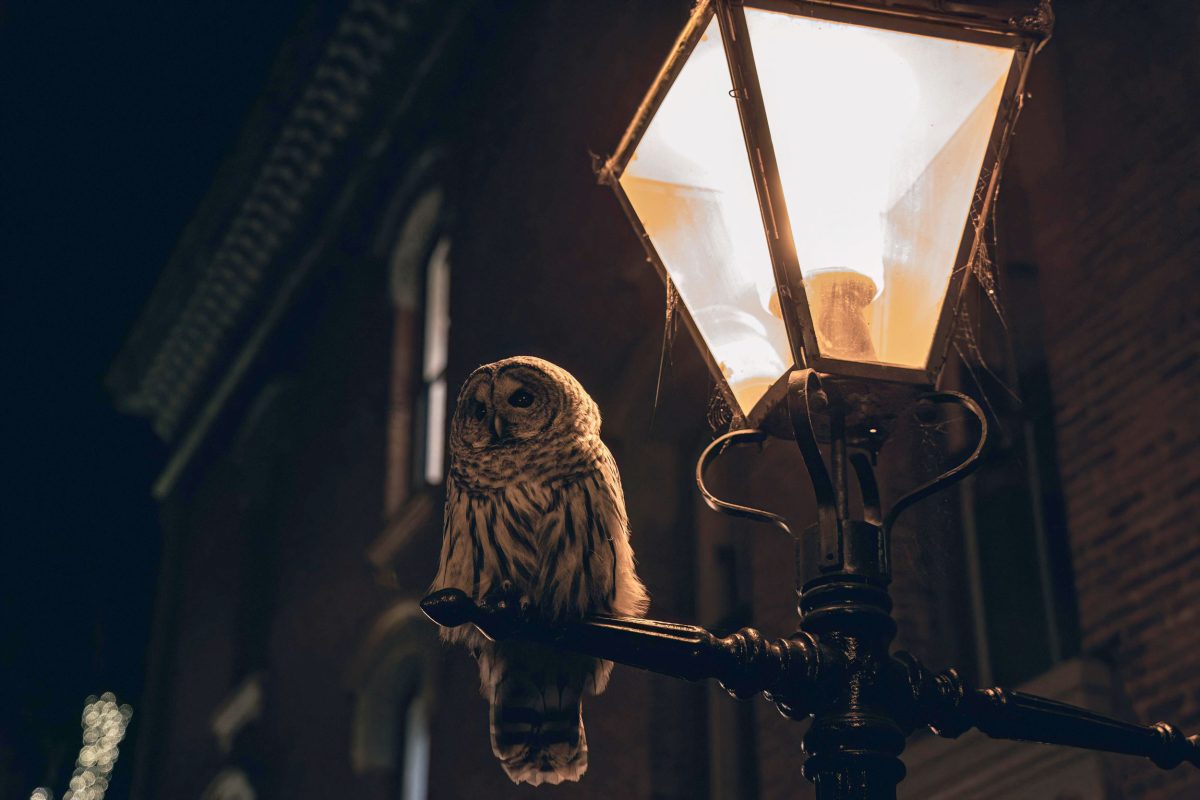
Residents regularly sight barred owls in downtown Victoria, British Columbia. Photo by Nick Maedel/Alamy Stock Photo
Have a look at eBird, says Ann Nightingale, a volunteer with the nonprofit Rocky Point Bird Observatory on Vancouver Island. eBird is an online database of bird sightings. It’s not perfect—no one has added the barred owl couple that nests across the street from my house, for instance—but it gives a snapshot of how common barred owls have become on much of the West Coast. Most sightings are in cities, towns, recreation areas, and other places where people gather, but Nightingale says there’s no doubt the owls are also in forests far from city centers.
And that, it turns out, is a problem for other owls.
The Severe Struggle Between Similar Species
My copy of Charles Darwin’s On the Origin of Species clocks in at 703 pages, and much of its length can be attributed to the numerous examples Darwin employs to support his thesis. He points out that species of the same genus with similar habits find it most challenging to coexist—one rat species replacing another rat species, Asiatic cockroaches replacing their Russian congeners, and mistle thrushes replacing song thrushes in Scotland.
So is the case with barred owls and northern spotted owls, which are native to the drippy, dark, and tangly temperate rainforests stretching from coastal Northern California to British Columbia. Elusive and reclusive, northern spotted owls were one of the later bird species Europeans identified and named in North America. One early-20th-century collector described searching for them as “most unsatisfactory.”
As loggers transformed trees into lumber beginning in the late 19th century, northern spotted owls became harder to find. In 1907, a collector shot one in the vicinity of Seattle. As late as 1937, a keen birder detected one near Portland, Oregon. And in Vancouver in September of 1947, what was probably the last northern spotted owl living in the city flumped on the street at the corner of Granville and West Hastings Streets with a pigeon in its talons, much like the barred owl that recently startled Vancouverites waiting for a bus just four blocks away.

In the past couple of decades, barred owls have inundated northern spotted owl habitat. Researchers worry that this will sabotage the recovery of the threatened (in the United States) and endangered (in Canada) birds. Map data from ArcGIS, with range data from IUCN
As in Vancouver, barred owls seem to be replacing and displacing northern spotted owls along much of the Pacific Northwest. Northern spotted owls are specialists, committed to old-growth forest. They are specific in their needs—food, shelter, and safety—and have difficulty adapting to the changes wrought by colonizers. In the United States, the population of northern spotted owls declined by 65 to 85 percent between 2005 and 2017, to an estimated 15,000. In British Columbia, most members of the species—just 37 in 2023, with chicks on the way—live at a breeding facility in the city of Langley. In the wild, only one has been confirmed.
The same patchy post-logging habitat that has caused northern spotted owl populations to plummet created an opportunity for barred owls. The bigger barred owls even prey on northern spotted owls and appropriate their nest cavities. And when not making war, they make love, which can be just as dangerous. On March 23, 1989, researchers at Baker Lake, in Washington’s Cascade Range, spied a hybridized owl—a “sparred owl.” A few more followed, though such canoodling seems rare overall.
The United States Fish and Wildlife Service (USFWS) would like to halt barred owls’ “vaulting ambition,” as Shakespeare might put it. More on that later.
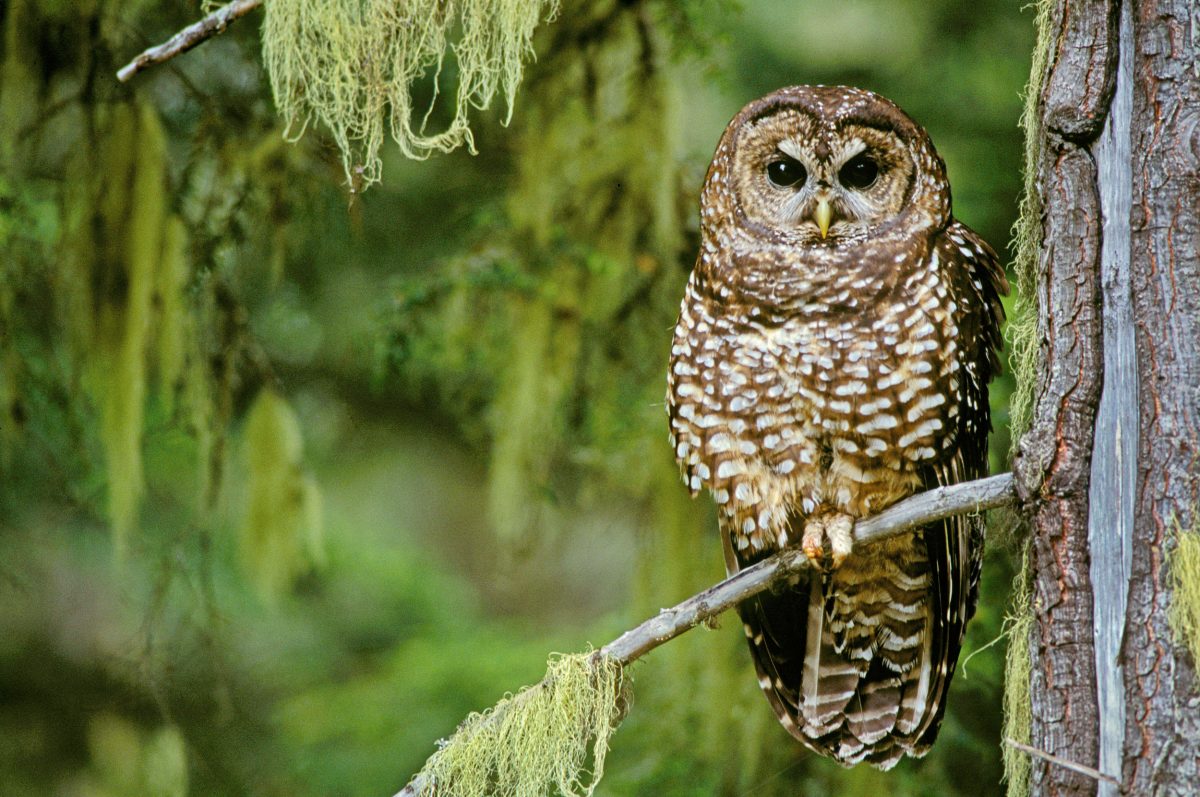
Northern spotted owls are inextricably tied to old-growth forest habitat. Photo by Greg Vaughn/Alamy Stock Photo
To Quote Darwin: “We will now discuss in a little more detail the Struggle for Existence”
On Vancouver Island, where I live, barred owls are usurping another native species—the coastal subspecies of the western screech owl. Once, Islanders would have been familiar with this inconspicuous, diminutive owl’s call. The males hoot like crazy, sounding like a bouncing ball that ends in a fast dribble, a sonorous claim to territory or an attempt to woo the ladies. Alas, their distinctive hoo-hoo-hoo-hoo-hoo-ooo-ooo-oooo broadcasts their whereabouts to barred owls on the hunt. Western screech owls, small enough to cup in your hands, are snack-sized for their bigger barred brethren.
No one knows the population of the little owl before barred owls busted into their island habitat. They were common on Vancouver Island in 1972 and uncommon by 2005. But like survivors in the horror flick A Quiet Place, the remaining western screech owls may have embraced silence to avoid deadly attacks. Today, they may hoot less often, so they may be undercounted. (The same may be true of the northern spotted owls.)
Strategic. But smart enough to ultimately outwit barred owls? “Barred owls seem to be quick learners,” Nightingale says.
Since 2002, Nightingale and her team have trapped and banded yet another species of owl, northern saw-whet owls, as they migrate on southwestern Vancouver Island. They’ve found that whenever more barred owls are around, they also see more migrating saw-whets. That’s likely because barred owls chase the saw-whets into mist nets erected by Nightingale’s team. The volunteers stay one step ahead by setting up scarecrows, stationing volunteers at the nets, and affixing bells to the nets to scare off (very occasionally) barred owls—the ever-clever owls would likely learn that the tinkle of bells leads to yum. Sometimes, the risk of predation is just too high, so the team closes their nets to save individual saw-whets, data be damned.
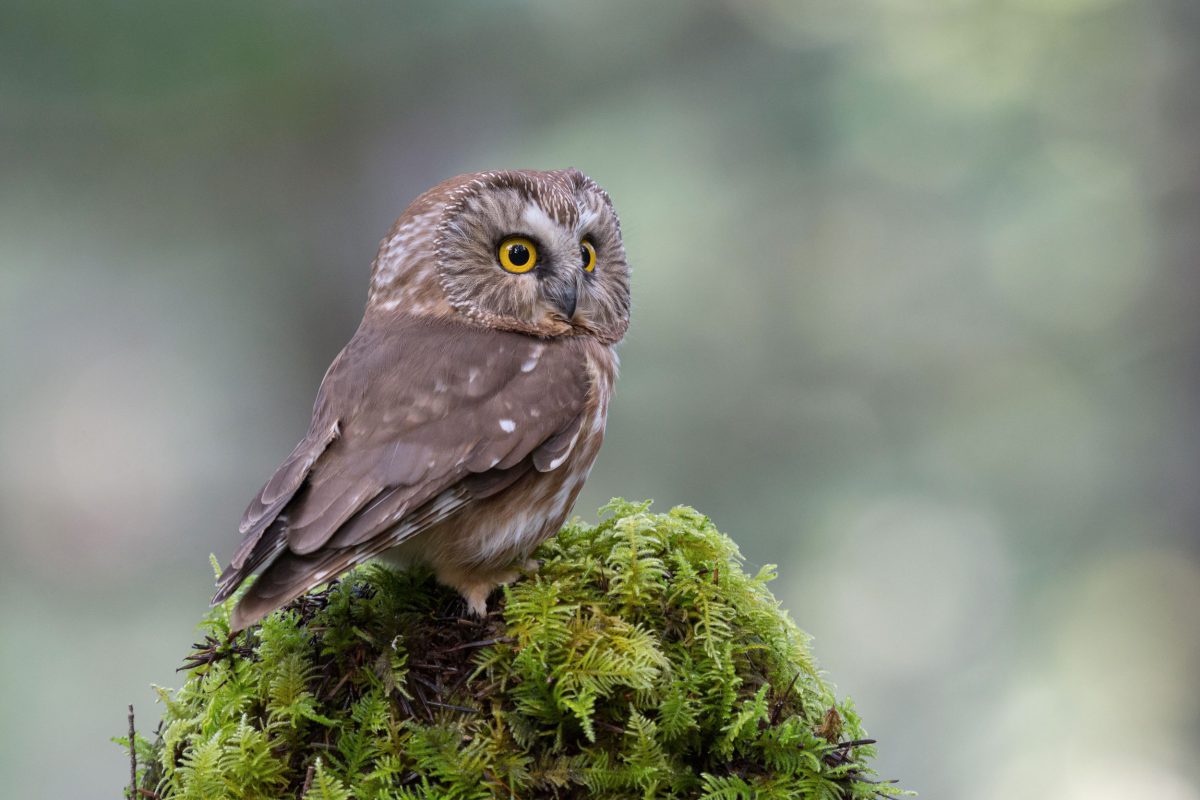
Barred owls prey on other owls, including northern saw-whet owls. Photo by Stuart Clarke/Alamy Stock Photo
Wherever they call home, barred owls catch on fast: In North Carolina, Bierregaard only needed three tries to teach a barred owl that a whistle meant a free mouse. On Vancouver Island, Nightingale and her crew wonder if barred owls have some kind of communication system that revolves around hunting, because, she says, “they seem to be learning faster than they ought to be.” Faced with the barred owls’ nimble intellect, other owls have to adapt their behaviors—sometimes to their own detriment.
Death of an Owl
There are some checks on barred owls’ westward expansion. One night, wandering through Beacon Hill Park, not far from my house in downtown Victoria, I hear a check—two of them. I’ve been listening for barred owls, but instead I hear a pair of great horned owls—which are native to practically all of North and Central America and into South America—discussing owl things in the trees above me. Great horned owls prey on barred owls. So do goshawks. So do speeding vehicles.
“Barred owls tend to fly into cars,” Bierregaard says. Or at least, they do in some places, which is one reason why concerned citizens brought 170 dead or injured barred owls to a Vancouver area wildlife rehab center in 2023. True to their penchant for never reading books or scientific articles about themselves, though, barred owls in Manitoba rarely seem to end up as roadkill. “They tend not to swoop low to the ground,” says Jim Duncan, the owl expert there. Eventually, he figured out that barred owls were flying above the nets he set to catch and tag them. Because they mostly fly high in Manitoba, they seem to rarely collide with cars.
One of their biggest killers is the USFWS. From 2013 to 2021, agency sharpshooters killed 3,000 barred owls in four study sites across the Pacific Northwest to prove that culling would help save northern spotted owls, a threatened species in the United States. It did, to a point: killing barred owls slowed the decline of northern spotted owls but didn’t stop it. Still, in November 2023, the agency announced an even more radical proposal: culling 470,000 barred owls in Northern California, Oregon, and Washington over 30 years. North of the border, a smaller but equally lethal effort is underway. From 2007 to 2021, British Columbia’s Northern Spotted Owl Recovery and Breeding Program relocated 108 barred owls and shot 42.
Biologists, wildlife advocates, and many others debate the efficacy and ethics of such culls. The old-growth habitat that northern spotted owls need cannot be restored in just 30 years, and some studies predict that no amount of barred owl culling will stop northern spotted owls from going extinct. The reservoir of barred owls, meanwhile, is deep. They reproduce at higher rates than spotted owls, they live more densely, and they are good at edging into whatever habitat is available.
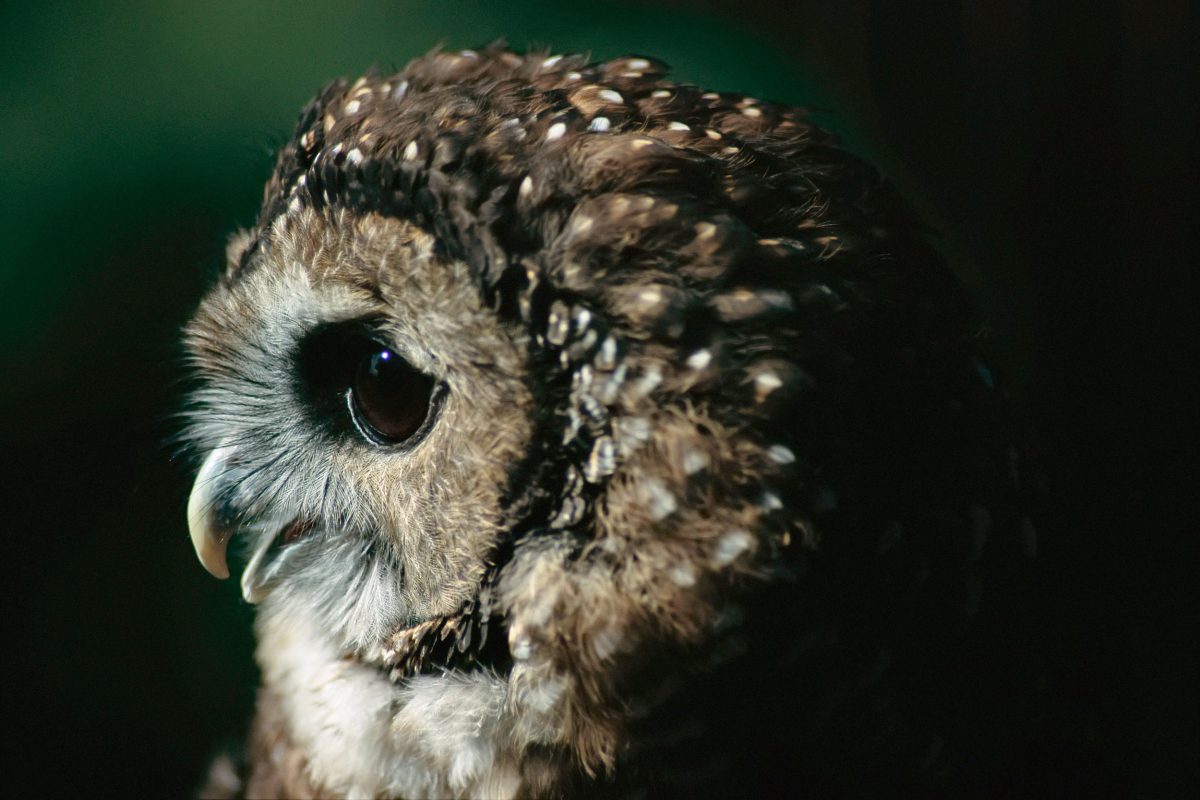
To save the remaining northern spotted owls in the United States, the US Fish and Wildlife Service has proposed culling close to half a million barred owls. Photo by Design Pics Inc./Alamy Stock Photo
On the Futility of Fixing Nature at a Static Point
Each of the owl experts I speak with gives a long exhale when I ask if killing almost half a million barred owls is a good idea. The world is a richer place with northern spotted owls, they say. There is no protecting northern spotted owls without old-growth forest protection, they say. Killing barred owls to save northern spotted owls in the Pacific Northwest is a forever war, they say.
Each has sympathy for colleagues who have spent decades trying to save spotted owls, to little avail. And none believes that we should give up on a species whose loss is directly tied to human activities. But at the same time, nature is dynamic and change is inevitable. Barred owls are simply doing what any species would do: seizing opportunities to expand their range and grow their population. For better or worse, their evolutionary journey has perfectly positioned them to thrive now, amid a human-altered landscape, in habitat that has welcomed and encouraged all manner of native wildlife to proliferate beyond their historical boundaries—from red foxes to yellow-faced bumblebees to raccoons.
Perhaps, in a world forever shifting, fixing our notions of nature to some idealized, precolonial past only prevents us from appreciating the owls we share our homes with now—the ones outside our kitchen windows and in our urban parks, the ones swirling around us on a downtown street corner, the ones that came from somewhere else and appeared seemingly overnight, asking us to think deeply and ask difficult questions about ourselves and our role in the lives of our nonhuman neighbors. Perhaps, in paying attention to and caring for these new neighbors, we might ensure that we never again have to make the choice between killing one creature and saving another.
The author gratefully acknowledges the writer Sandra Steingraber for inspiring this story. Steingraber’s essay “The Fall of a Sparrow” was published in Orion Magazine in 2008.

